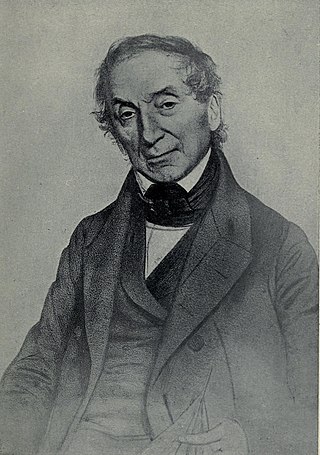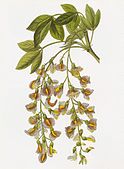
Nathaniel Wolff Wallich was a surgeon and botanist of Danish origin who worked in India, initially in the Danish settlement near Calcutta and later for the Danish East India Company and the British East India Company. He was involved in the early development of the Calcutta Botanical Garden, describing many new plant species and developing a large herbarium collection which was distributed to collections in Europe. Several of the plants that he collected were named after him.

John Lindley FRS was an English botanist, gardener and orchidologist.

Plantae Asiaticae Rariores is a horticultural work published in 1830–1832 by the Danish botanist Nathaniel Wallich.

Heinrich Gustav Reichenbach was a botanist and the foremost German orchidologist of the 19th century. His father Heinrich Gottlieb Ludwig Reichenbach was also a well-known botanist.

Drakaea is a genus of 10 species in the plant family Orchidaceae commonly known as hammer orchids. All ten species occur only in the south-west of Western Australia. Hammer orchids are characterised by an insectoid labellum that is attached to a narrow, hinged stem, which holds it aloft. The stem can hinge only backwards, where the broadly winged column carries the pollen and stigma. Each species of hammer orchid is pollinated by a specific species of thynnid wasp. Thynnid wasps are unusual in that the female is flightless and mating occurs when the male carries a female away to a source of food. The labellum of the orchid resembles a female thynnid wasp in shape, colour and scent. Insect pollination involving sexual attraction is common in orchids but the interaction between the male thynnid wasp and the hammer orchid is unique in that it involves the insect trying to fly away with a part of the flower.

Robert Wight was a Scottish surgeon in the East India Company, whose professional career was spent entirely in southern India, where his greatest achievements were in botany – as an economic botanist and leading taxonomist in south India. He contributed to the introduction of American cotton. As a taxonomist he described 110 new genera and 1267 new species of flowering plants. He employed Indian botanical artists to illustrate many plants collected by himself and Indian collectors he trained. Some of these illustrations were published by William Hooker in Britain, but from 1838 he published a series of illustrated works in Madras including the uncoloured, six-volume Icones Plantarum Indiae Orientalis (1838–53) and two hand-coloured, two-volume works, the Illustrations of Indian Botany (1838–50) and Spicilegium Neilgherrense (1845–51). By the time he retired from India in 1853 he had published 2464 illustrations of Indian plants. The standard author abbreviation Wight is used to indicate this person as the author when citing a botanical name.

Botanical illustration is the art of depicting the form, color, and details of plant species. They are generally meant to be scientifically descriptive about subjects depicted and are often found printed alongside a botanical description in books, magazines, and other media. Some are sold as artworks. Often composed by a botanical illustrator in consultation with a scientific author, their creation requires an understanding of plant morphology and access to specimens and references.

The Botanical Register, subsequently known as Edwards's Botanical Register, was an illustrated horticultural magazine that ran from 1815 to 1847. It was started by the botanical illustrator Sydenham Edwards, who had previously illustrated The Botanical Magazine, but left after a dispute with the editors. Edwards edited five volumes of The Botanical Register in five years, before his death in 1819. During this period, the text was provided by John Bellenden Ker Gawler, and Edwards himself provided paintings, which were engraved and hand-coloured by others.

Augusta Hanna Elizabeth Innes Withers, was an English natural history illustrator, known for her illustrating of John Lindley's Pomological Magazine and her collaboration with Sarah Drake on the monumental Orchidaceae of Mexico and Guatemala by James Bateman. She was appointed "Flower Painter in Ordinary" to Queen Adelaide and later to Queen Victoria. She also produced illustrations for Benjamin Maund's Botanis, the Transactions of the Horticultural Society of London, the Illustrated Bouquet (1857-1863) and Curtis's Botanical Magazine.

Dendrobium jenkinsii, the Jenkins's dendrobium, is a species of orchid. It is native to southern China (Yunnan), the eastern Himalayas and northern Indochina.

Graphorkis is a genus of flowering plants from the orchid family, Orchidaceae. It contains 4 known species, native to Africa and to Madagascar and other islands of the Indian Ocean.

Caleana, commonly known as duck orchids, is a genus of flowering plants in the orchid family, Orchidaceae that is found in Australia and New Zealand. The Australian species are found in all states but have not been recorded in the Northern Territory. Duck orchids have a single leaf and one or a few, dull-coloured, inconspicuous flowers. Most species are found in Western Australia but one species occurs in eastern Australia and one occurs in eastern Australia and New Zealand. Orchids in this genus as well as the hammer orchids (Drakaea) are pollinated by male thynnid wasps.

Maxim Gauci, born Massimo Gauci, was a Maltese lithographer and painter who was active in the United Kingdom in the 19th century. He was an early exponent of lithography for botanical illustration.
Alex Drum Hawkes (1927–1977) was an American botanist and cookbook author who lived in Coconut Grove, Florida & Kingston, Jamaica. Alex specialized in orchids, bromeliads, palm trees, fruits, vegetables, and nuts. Named the orchid genera Flickingeria, and Paraphalaenopsis and travelled the world extensively, particularly the Caribbean & Latin America during the 1940s - 1970s collecting plants and authentic regional recipes.

Charlotte Caroline Sowerby (1820–1865) was a 19th-century British scientific illustrator and a member of the extensive Sowerby family of naturalist-illustrators.
Deborah Lambkin is an Irish botanical artist who has been the official Orchid artist for the Royal Horticultural Society.

Dendrobium densiflorum is a species of epiphytic or lithophytic orchid, native to Asia. It has club-shaped stems, three or four leathery leaves and densely flowered, hanging bunches of relatively large pale yellow and golden yellow flowers.

Nellie Roberts was an English botanical and scientific illustrator.

Lady Sarah Elizabeth Hay-Williams was an English artist and botanical illustrator. She was born on 9 July 1801 to Sarah Amherst and William Amherst, 1st Earl Amherst. She travelled with her parents to India and while there completed several watercolour paintings now held in the collection of the British Library. She later married Sir John Hay-Williams in 1842. In 1846 Hay-Williams contributed a watercolour to Edwards's Botanical Register. After returning to the United Kingdom she had two children including Margaret Verney. She died in 1876 at Chateau Rhianfa in Anglesey on 8 August 1876.

Rungiah aka Rungia or Rungia Raju was a 19th-century Indian botanical illustrator, noted for producing a large number of images for Robert Wight's books on Indian flora. The Raju family were painters of the Kshatriya caste of Tanjore, and were originally from the Telugu-speaking region in the state of Andhra Pradesh.






























